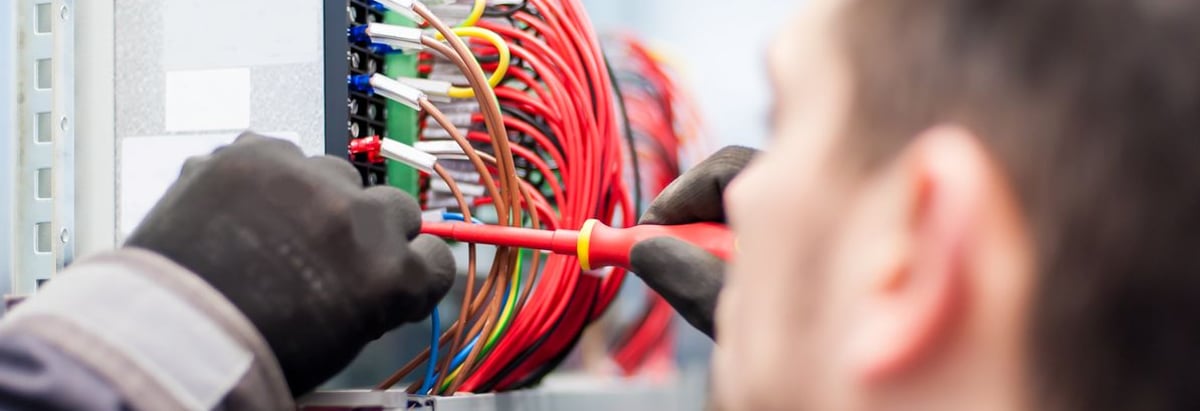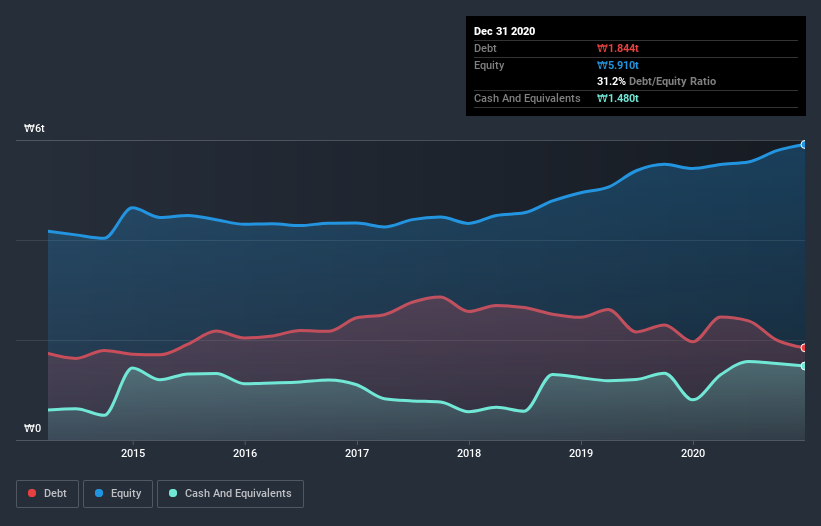- South Korea
- /
- Electronic Equipment and Components
- /
- KOSE:A009150
We Think Samsung Electro-Mechanics (KRX:009150) Can Stay On Top Of Its Debt

Howard Marks put it nicely when he said that, rather than worrying about share price volatility, 'The possibility of permanent loss is the risk I worry about... and every practical investor I know worries about.' It's only natural to consider a company's balance sheet when you examine how risky it is, since debt is often involved when a business collapses. We note that Samsung Electro-Mechanics Co., Ltd. (KRX:009150) does have debt on its balance sheet. But is this debt a concern to shareholders?
Why Does Debt Bring Risk?
Debt is a tool to help businesses grow, but if a business is incapable of paying off its lenders, then it exists at their mercy. Part and parcel of capitalism is the process of 'creative destruction' where failed businesses are mercilessly liquidated by their bankers. However, a more usual (but still expensive) situation is where a company must dilute shareholders at a cheap share price simply to get debt under control. Of course, plenty of companies use debt to fund growth, without any negative consequences. The first thing to do when considering how much debt a business uses is to look at its cash and debt together.
View our latest analysis for Samsung Electro-Mechanics
How Much Debt Does Samsung Electro-Mechanics Carry?
As you can see below, Samsung Electro-Mechanics had ₩1.84t of debt at December 2020, down from ₩1.96t a year prior. On the flip side, it has ₩1.48t in cash leading to net debt of about ₩364.3b.

How Strong Is Samsung Electro-Mechanics' Balance Sheet?
We can see from the most recent balance sheet that Samsung Electro-Mechanics had liabilities of ₩1.91t falling due within a year, and liabilities of ₩1.40t due beyond that. On the other hand, it had cash of ₩1.48t and ₩996.5b worth of receivables due within a year. So its liabilities outweigh the sum of its cash and (near-term) receivables by ₩838.9b.
Of course, Samsung Electro-Mechanics has a titanic market capitalization of ₩15t, so these liabilities are probably manageable. Having said that, it's clear that we should continue to monitor its balance sheet, lest it change for the worse.
We measure a company's debt load relative to its earnings power by looking at its net debt divided by its earnings before interest, tax, depreciation, and amortization (EBITDA) and by calculating how easily its earnings before interest and tax (EBIT) cover its interest expense (interest cover). The advantage of this approach is that we take into account both the absolute quantum of debt (with net debt to EBITDA) and the actual interest expenses associated with that debt (with its interest cover ratio).
Samsung Electro-Mechanics has a low net debt to EBITDA ratio of only 0.22. And its EBIT covers its interest expense a whopping 22.3 times over. So you could argue it is no more threatened by its debt than an elephant is by a mouse. And we also note warmly that Samsung Electro-Mechanics grew its EBIT by 12% last year, making its debt load easier to handle. There's no doubt that we learn most about debt from the balance sheet. But ultimately the future profitability of the business will decide if Samsung Electro-Mechanics can strengthen its balance sheet over time. So if you're focused on the future you can check out this free report showing analyst profit forecasts.
Finally, a business needs free cash flow to pay off debt; accounting profits just don't cut it. So it's worth checking how much of that EBIT is backed by free cash flow. In the last three years, Samsung Electro-Mechanics's free cash flow amounted to 23% of its EBIT, less than we'd expect. That weak cash conversion makes it more difficult to handle indebtedness.
Our View
The good news is that Samsung Electro-Mechanics's demonstrated ability to cover its interest expense with its EBIT delights us like a fluffy puppy does a toddler. But truth be told we feel its conversion of EBIT to free cash flow does undermine this impression a bit. When we consider the range of factors above, it looks like Samsung Electro-Mechanics is pretty sensible with its use of debt. That means they are taking on a bit more risk, in the hope of boosting shareholder returns. There's no doubt that we learn most about debt from the balance sheet. But ultimately, every company can contain risks that exist outside of the balance sheet. For example, we've discovered 1 warning sign for Samsung Electro-Mechanics that you should be aware of before investing here.
When all is said and done, sometimes its easier to focus on companies that don't even need debt. Readers can access a list of growth stocks with zero net debt 100% free, right now.
If you’re looking to trade Samsung Electro-Mechanics, open an account with the lowest-cost* platform trusted by professionals, Interactive Brokers. Their clients from over 200 countries and territories trade stocks, options, futures, forex, bonds and funds worldwide from a single integrated account. Promoted
New: Manage All Your Stock Portfolios in One Place
We've created the ultimate portfolio companion for stock investors, and it's free.
• Connect an unlimited number of Portfolios and see your total in one currency
• Be alerted to new Warning Signs or Risks via email or mobile
• Track the Fair Value of your stocks
This article by Simply Wall St is general in nature. It does not constitute a recommendation to buy or sell any stock, and does not take account of your objectives, or your financial situation. We aim to bring you long-term focused analysis driven by fundamental data. Note that our analysis may not factor in the latest price-sensitive company announcements or qualitative material. Simply Wall St has no position in any stocks mentioned.
*Interactive Brokers Rated Lowest Cost Broker by StockBrokers.com Annual Online Review 2020
Have feedback on this article? Concerned about the content? Get in touch with us directly. Alternatively, email editorial-team (at) simplywallst.com.
About KOSE:A009150
Samsung Electro-Mechanics
Manufactures and sells various electronic components in Korea, China, Southeast Asia, Japan, the Americas, and Europe.
Flawless balance sheet and undervalued.


